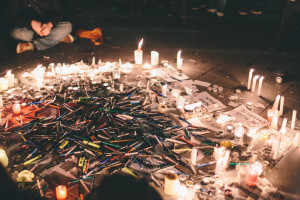#JesuisCharlie
Posted: January 30, 2015, 4:32 p.m.
by Laura Gregory.
The advent of social media has allowed people from all over the world to communicate as easily as a simple tap on an iPhone screen. Particularly, in the wake of great national tragedies, the people of the world unite through such modern tools of mass communication to show their support and offer their condolences.
Such was the case on Jan. 7, 2015, after the deadly attack at the office of satirical magazine Charlie Hebdo in Paris, France. Two masked gunmen, reportedly linked to Al-Qaeda, entered the office that morning killing 11 people and injuring several others. The attack was in response to the magazine’s controversial cartoons of Muhammad.
Shortly after news of the attack broke, Twitter users across the world were tweeting with the hashtag “Je suis Charlie,” which means “I am Charlie” in French. According to The Telegraph, “At its height, the tag was tweeted at a rate of 6,500 times a minute and featured in 3.4 million tweets in just one 24-hour period”. However, this simple hashtag held a much deeper meaning than just support for the victims in the attack.

#JesuisCharlie was used worldwide as a rallying cry in support of the basic ideals of free speech and freedom of expression that those of us in media industries utilize on a daily basis. The phrase enabled people around the world, including those who may never have even heard of Charlie Hebdo prior to the attack, to show support on a more personal level by identifying as Charlie. Modern mass communication allowed the people of the world to unite under tragic circumstances to project a face of strength and determination in maintaining the basic ideals of democracy.
One of France’s largest media organizations, Groupe Le Monde, announced that it would be offering its equipment and staff in order to ensure that Charlie Hebdo could continue to publish. The media group encouraged other groups in France to join in supporting Charlie Hebdo, citing the need to “preserve the principles of editorial independence and freedom of thought — principles that are fundamental to our democracy.”
The magazine did not hide in the aftermath of the tragedy. Instead, the surviving editors and writers persevered and sold a record number of copies. The magazine traditionally printed 60,000 copies. The day after the attack, the magazine staff announced they would print 1 million copies. Shortly after, the printed number was increased to 3 million. Ultimately, 5 million copies were printed worldwide.

The national media attention that Charlie Hebdo received in the wake of the tragedy on Jan. 7 was aided by the modern developments in mass communication, particularly the use of social media. Twitter especially allowed users across the world to communicate in response to the deadly attack.
While Charlie Hebdo may be just one example of an event that received widespread attention through social media, it should resonate with individuals connected to the media industry. The individuals in the Charlie Hebdo office may have been the direct victims of the attack that day, but the concepts of free speech and expression were the victims on a global scale.




